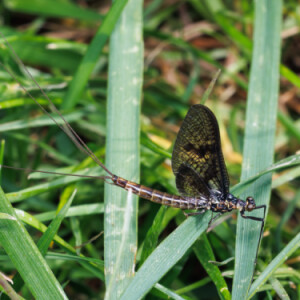Brutal
Talk about Nature, red in tooth and claw.
Your entire life has been leading up to this. You spend two years as a nymph, living in a burrow on the river bed, using your gills to create a water current to provide you with oxygen and food. Then, when you're ready to transform, you build up gas inside your exoskeleton to give you buoyancy, and you rise to the river surface - with your exoskeleton already splitting to allow your initial winged form, the dun, to emerge. Your dun wings are designed to repel water, but if you can't get fully out of your exoskeleton, or you fail to break through the surface tension of the water, you'll drown. Alternatively, a fish might catch sight of you, especially if you're struggling at the surface, in which case you'll be eaten.
But say none of those bad things happen: you get from burrow to river surface, you eclose successfully as a dun, and you make it to the emergent vegetation at the river's edge. Then you have to wait. Duns are poor flyers and are not sexually mature, and a further transformation is necessary to get them to adulthood. So, after a hiatus of maybe just a few hours, but up to a couple of days, you moult again - the only winged insect in existence to do this - and finally emerge in your full pomp. You're now ready to spend your last few days on earth dancing in the air to attract a mate, so you can achieve immortality by passing on your DNA to a new generation.
Or not.
He got so close... but for him it ends here. As far as I can see around the jaws of the Banded Demoiselle who spoiled his party, the victim is a dun, or sub-adult, Ephemera vulgata, commonly called the Drake Mackerel. My second photo shows a resting adult male of the same species, who as you can see is generally darker and much more strongly marked. Having survived to adulthood, he's already started to dance - the strange rising and falling motion that I always think of as pogoing being designed to attract a female. If he's successful they will copulate briefly on the wing, and she will then immediately deposit the eggs he's fertilised, after which she will drop into the river and die. He may yet have some more dancing in him, but he has no mouthparts and can't feed, so ultimately his energy will run out, and he too will die.
Having watched it, I can tell you that the end of the Mayfly's life was painful and protracted. But for all that the Banded Demoiselle is a ferocious little predator, his life could end just as brutally. The woodland surrounding this clearing is full of nesting birds with hungry chicks to feed, and very soon there will be dragonflies patrolling the fishing pegs as well, any of whom will take him down if he's unwary or too slow. If he's to complete his own life cycle successfully he has to survive long enough to breed, and maybe the protein he's consuming here will make the difference between success and failure.


Comments
Sign in or get an account to comment.


